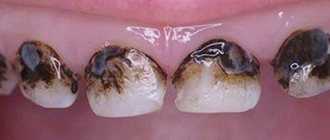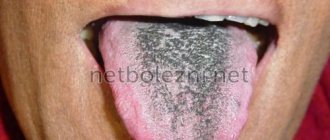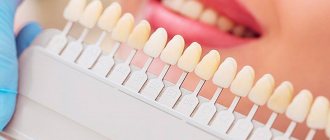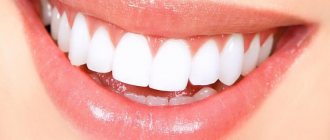In pediatric dentistry, one of the most common reasons for visiting a doctor is black plaque on a child’s baby teeth. It can appear at any age, and sometimes completely unexpectedly: some parents say that the baby went to bed with normal teeth, and woke up with noticeable blackening. Why do young children’s teeth turn black, what should be done in such cases, and how dangerous is this blackening?
What is Priestley's plaque?
Priestley's plaque is dark stains on children's baby teeth, which are a consequence of the activity of certain types of bacteria.
The appearance of a dark, almost black plaque on a child’s teeth can be observed at any age - both at one year old and at an older age. This is a very common occurrence on baby teeth.
As a result, due to black teeth in children, the smile becomes unattractive, and bad breath often appears.
Priestley's plaque on a child photo
However, it is not the child’s black teeth that should alert parents, but the fact that the appearance of this symptom is a signal that some kind of malfunction has occurred in the baby’s body. And to eliminate it, the first thing you need to do is consult a doctor - a pediatric dentist.
RESULT
Mothers should not panic, because black plaque is a common problem for children. If you use the given recommendations about proper food and oral hygiene, there will be no consequences. If desired, plaque can be removed with the help of a dentist. But many dentists recommend waiting until the baby teeth are replaced by molars.
It is rare, but it happens that dark spots on the enamel are signs of disease (diabetes mellitus). Therefore, it is better to immediately eliminate all risks so as not to disturb yourself and your child. If we are talking about adults and not children, then you cannot put off going to the dentist. If in children plaque is a common phenomenon, which extremely rarely indicates something serious, then in adults this is completely different.
Even if Priestley’s plaque turned out to be a consequence of caries, the enamel may soon deteriorate and the teeth will begin to crumble. This problem is more serious for adults, because... molars are no longer restored. Maintaining oral hygiene and proper nutrition is an excellent prevention of dental problems.
Causes of black plaque on children's teeth
There are many factors that cause black plaque on baby teeth. It is almost impossible to independently identify the cause, so you need to consult a doctor.
The most common causes of its occurrence are the following:
- Priestley's plaque in a child is the most common cause. This is due to special bacteria that produce a black pigment. It settles on the enamel, but goes away completely with age and almost never transfers to permanent teeth. This phenomenon is not dangerous to health and is considered only an aesthetic problem. Plaque can be removed at the dentist, but after a while it will still return. So you just need to wait until it goes away on its own.
- Caries. An equally common, but much more serious reason, since baby teeth are susceptible to the development of disease. They first turn yellow, black spots and spots appear, after which they turn black. The danger is that the disease will spread to permanent teeth if treatment is not started immediately.
- Dysbacteriosis. This disease can also cause problems with the digestive tract. Often occurs due to poor nutrition of the child, long-term use of antibiotics, and the presence of chronic liver or intestinal diseases.
- Excess iron. Quite often, young children are prescribed iron supplements, which often leads to the appearance of dark deposits on the teeth. At the same time, the color of the plaque can change from black to dark purple or brown.
In addition to the reasons listed, plaque can appear due to a lack of calcium, which certainly affects the teeth first. Sometimes it occurs due to impaired intestinal microflora or as a result of poor heredity - if the child’s parents had the same problem in childhood. In any case, to find out exactly the cause, it is necessary to consult a doctor in a timely manner for examination.
Diagnosis and treatment methods of Priestley plaque
The appearance of black plaque can be the result of various diseases. In order to prevent them from starting and to prevent the development of complications, it is necessary to carry out a number of diagnostic measures. Even if a small spot appears on a tooth, you should visit a doctor and undergo laser diagnostics.
If it is caries, then at an early stage of development it is much easier to cure. In addition, the doctor may prescribe additional tests: blood and urine tests. Depending on the results obtained, appropriate treatment methods are selected:
- If problems with the gastrointestinal tract are identified, it is necessary to review the child’s nutritional system. In this case, a special diet is prescribed and some foods are excluded from the diet.
- Lack of calcium or excess iron can be easily treated by taking corrective medications and eating certain foods in greater or lesser quantities.
- When identifying caries at an early stage , dental procedures such as silver plating or fluoridation can help. The doctor treats the teeth with a special solution, which helps prevent further development of the disease and wait for healthy permanent teeth.
- Common Priestley plaque can be removed by professional cleaning by a doctor. But, unfortunately, this is not a guarantee that it will not appear again after a while.
If stains or plaque on the teeth cause pain or discomfort to the child, fillings are used to preserve the teeth and eliminate discomfort.
Causes of caries
Caries occurs “thanks” to microorganisms living in the thickness of dental plaque. These bacteria - primarily streptococci, lactobacilli and actinomycetes - process food debris that remains on the teeth and produce acids that corrode the tooth enamel, leaching calcium from it. The tooth enamel begins to deteriorate.
The activity of bacteria varies from person to person: it is higher if a person brushes their teeth irregularly or not thoroughly enough, since soft interdental plaque is an excellent nutrient medium for them.
Why do you need to remove Priestley plaque?
Not all children develop dark plaque on their teeth. This is due to the fact that the body reacts differently to changes in diet, environment and other factors.
In some cases, the spots may develop gradually, and in others they form abruptly, in just a few days. At the same time, age is not important: spots can appear already in the first months after teething, although on average they form at 2 years.
There are several reasons for removing Priestley plaque in children:
- Firstly, this is an aesthetic defect that attracts unnecessary attention to the baby’s mouth.
- Secondly, bad breath due to bacterial growth.
- Thirdly, under the guise of spots, the beginnings of carious lesions of the enamel may be hidden.
You can get professional services from a dentist and advice on this issue in Moscow at the Aesculapius dental clinic. Our specialists constantly encounter similar formations in children and know very well how to deal with it.
In just one session we will restore healthy enamel color using completely safe methods. At the same time, services for removing black plaque on a child’s teeth are available inexpensively in our clinic. We cooperate with each client on individual terms and adapt to the patient’s needs.
Also, if necessary, our doctors are ready to perform qualified treatment of childhood caries and other dental procedures. Our medical complex provides a wide range of services and can help with any oral ailment.
Clinical picture of caries
The first stage of the carious process
Caries occurs in the spot stage and in the superficial layers of enamel. Then we observe a stain on the surface of the tooth, which gradually becomes more dull, rough and porous.
The second stage of the carious process
If the enamel is chipped and a defect is formed, the tooth becomes more sensitive to irritants. Transient pain appears after eating cold, sweet and sour foods.
The third stage of the carious process
A carious cavity in dentin (tooth tissue located under the enamel). In this case, toothache appears depending on the situation, for example, when chewing on a diseased tooth or when there is a sudden change in the temperature of food, air, or when food gets into the cavity of a damaged tooth.
The fourth stage of the carious process
With further destruction, a deep carious cavity appears in the tooth, which gradually increases in size, so that eventually the tooth is destroyed and the pain appears spontaneous and constant. At this stage, an urgent visit to the dentist is necessary, as this indicates damage to the nerve of the tooth. In this case, it is not always possible to save the tooth.
Meet our tooth fairies and find out prices
How does the procedure for removing black plaque on teeth work?
Reliably and safely getting rid of dark spots on enamel is possible only with a professional dentist. Self-removal of black plaque in children using various folk remedies can lead to damage to the surface of the teeth.
Therefore, you should not self-medicate, but it is better to immediately use the services of specialists. At the Esculapius clinic we will find the root cause of the violation of the natural microflora of the mouth and eliminate the aesthetic defect from the enamel. At the same time, we use only effective methods that guarantee the highest quality results.
To treat Priestley's plaque, the Air Flow device is used, as well as ultrasound. During the procedure, a mixture of water, air and soda crystals is sprayed onto the teeth under pressure. The flow removes various types of deposits not only from the surface of the tooth, but also from the interdental spaces.
For children who do not really like brushing their teeth using the Air Flow method, soft plaque is removed with special brushes and pastes. After professional cleaning, the teeth are polished and become smooth, due to which less plaque settles on the enamel.
This procedure is available in our clinic at a reasonable cost. In addition, it is inexpensive to perform silvering of baby teeth - a preventive measure to strengthen the enamel and protect against caries, as well as other hygiene procedures. With us, your child's smile will be healthy and beautiful.
The main dangers of dental plaque
Such deposits, regardless of their color, are a breeding ground for various bacteria, so they pose a danger to the child and require prompt removal. At the same time, the waste products of such microorganisms have an acidic environment, which has a destructive effect on tooth enamel.
In this case, the following diseases may become further development of plaque:
- Destruction of enamel;
- Formation of tartar;
- Caries;
- Gingivitis (inflammation of gum tissue);
- Periodontitis.
Possible complications after plaque formation in children
It is strictly not recommended to ignore the problem and wait until it goes away on its own (unless diagnostics have been carried out and the absence of diseases has been revealed).
Black plaque on a child’s teeth can be not only an aesthetic problem, but also a symptom of more serious and health-threatening diseases, which in their advanced form will require expensive and difficult treatment.
In addition, they can cause complications, which will also lead to unpleasant consequences:
- Inflammation and bleeding of the gums when eating or brushing teeth.
- The risk of developing various dental diseases increases, in particular caries, stomatitis and periodontal disease.
- Dense dark plaque quite often turns into tartar, so even with safe Priestley plaque, professional teeth cleaning is recommended at least once every six months.
- The appearance of bad breath, accompanied by toothache and a feeling of discomfort.
If the progression of plaque is caused by the lack of treatment for caries, the disease begins to fill deeper cavities, which leads to the development of pulpitis, periodontitis and other related diseases. As a result, baby teeth may need to be removed, which is highly undesirable.
Disease prevention
Preventive measures to prevent the development of dental diseases and the formation of plaque should be applied from the moment the baby first starts teething. The risk of unpleasant problems occurring can be significantly reduced by the following simple measures:
- Gentle oral care . Infants up to one year old can clean their gums with a cotton pad soaked in a decoction of chamomile, string, oak bark or sage. Special silicone attachments are also widely popular, which adults put on their fingers and thus clean the baby’s oral cavity. From the age of two, children must be taught to brush their teeth with a brush and toothpaste, and it is also advisable to rinse the mouth after each meal.
- Proper nutrition. This does not imply following any diets, but the child’s nutritional system should be designed in such a way as to limit his intake of sweets, sugar, confectionery and increase the consumption of healthy natural products. Sweets from the store are an excellent substitute for candied fruits, fruits and dried fruits.
- Timely abandonment of pacifiers and bottles. With prolonged use of a bottle or pacifier, an incorrect bite develops, dependence on accessories appears, and a black plaque forms, which in dentistry is called “bottle caries.” You should not delay in weaning your child off devices that he no longer needs.
- Maintaining the immune system. It is important to ensure that even in winter, the child has enough vitamins to maintain healthy teeth and the body as a whole.
By following these simple recommendations, you will ensure your child’s dental health and the beauty of a child’s smile.









